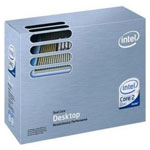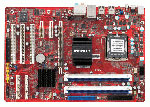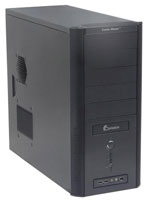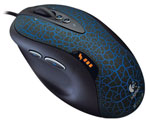Intel Midrange Gaming
Intel has been getting most of the attention in the past year with their Core 2 line of products, and with good reason. Even better is that competition with AMD has continued to drive down prices, to the point where we actually see a lot of very good Intel processors that cost less than $200. If we were to put together a system that was configured as close as possible to what we used in the AMD gaming platform on the previous page, we would need to make a few changes. However, trying to come up with identical features makes it difficult to cater to the strengths of a platform, so instead we simply picked the parts that we felt were the best fit for a midrange gaming system.
| Intel Midrange Gaming System |
| Hardware |
Component |
Price |
Rebates |
| Processor |
Intel Core 2 Duo E6550 (2.33GHz 1333FSB 4MB Shared) - Retail |
$175 |
|
| Motherboard |
DFI Blood Iron P35-T2RL (P35 ICH9R) |
$137 |
|
| Memory |
Patriot Extreme Performance 2x1GB PC2-8500 (PDC22G8500ELK) |
$139 |
$25 |
| Video Card |
XFX GeForce 8800GTS 320MB (PVT80GGHF4) |
$287 |
$20 |
| Hard Drive |
Western Digital Caviar SE16 320GB 7200RPM 16MB (WD3200AAKS) |
$80 |
|
| Optical Drive |
Samsung 20X DVD+R SATA (SH-S203B) |
$36 |
|
| Case |
Cooler Master Centurion 534 (RC-534-KKN2-GP) |
$66 |
$10 |
| Power Supply |
Corsair CMPSU-520HX |
$108 |
$10 |
| Display |
Acer AL2216Wbd 22" 5ms (1680x1050) |
$235 |
|
| Speakers |
Logitech X-530 5.1 70W Speakers |
$66 |
|
| Keyboard |
Saitek Eclipse USB Wired (PZ30AU) |
$40 |
|
| Mouse |
Logitech G5 Wired Adjustable Weight |
$52 |
$15 |
| Operating System |
Windows Vista Home Premium 32-bit (OEM) |
$105 |
|
| Bottom Line |
$1526 |
$1446 |
 |
We decided to jump right over the slightly cheaper E4000 series Intel CPUs and move up to their latest 1333 FSB dual-core offering. The E6550 goes for an even $175, but in terms of CPU performance it's practically untouchable by any of the stock Athlon X2 processors. The Athlon X2 6400+ does come pretty close in terms of raw performance, even managing to win in a few benchmarks by a small margin, but for $210 the 6400+ really can't be considered the better buy.
 |
If you're looking for cheaper alternatives, as mentioned on the last page the E4400 and E4500 would offer similar performance to the AMD platform. That would allow you to potentially make a few other upgrades or simply keep the savings. If on the other hand you want more performance, the E6750 costs an additional $20. The next step is a relatively large $85 increase before we get to anything truly noteworthy, and at that price point you get to choose between the 3.0 GHz E6850 or you can move to the quad-core Q6600. Without more graphics processing power, however, neither upgrade is likely to affect gaming performance for the foreseeable future.
For the motherboard, we tossed around quite a few ideas. In the end, dual GPU support didn't make the cut, which we don't view as a particularly major loss on a midrange system. There are motherboards that don't cost too much more that include dual physical x16 slots, but we figure most gamers should either purchase a single fast GPU or spend a lot more money and make the jump straight to dual high-end GPUs. Many people over the years have purchased a single GPU with the thought that they can upgrade to dual graphics cards in the future, only to find that by the time they really need the second GPU there are new single GPU solutions available that are more attractive overall.
 |
The DFI Blood Iron is your typical DFI "mainstream enthusiast" offering, providing a serious amount of tweaking and overclocking options at a price that won't break the bank. While you get great performance and overclocking, other features are unfortunately trimmed. Besides the aforementioned lack of a second x16 slot, FireWire support is also missing. If you would rather skip out on maximum overclocking and tuning options, there are plenty of reasonable alternatives.
 |
The Gigabyte GA-P35-DS3L doesn't really add any options, but it does save you $20 making it a good entry level P35 motherboard. If you're looking to shave off even more from the price, the abit IP35-E is selling for $102 shipped, plus a $20 mail-in rebate. The quality of that motherboard is a bit suspect, however, with quite a few users reporting compatibility problems and other quirkiness. We haven't had any serious issues with our own test subject, but you might need to exercise a bit more patience if you go with abit. Finally, at a price that's still lower than the DFI Blood Iron, the MSI P35 Neo2-FR brings CrossFire support back into the picture. All three of these motherboards are reasonable P35 alternatives, and if you want SLI you can always go with EVGA and one of their 680i offerings. 1333 FSB support can be a bit flaky at times with the 680i chipset, but you do get FireWire support.
 |
All of the other components remain the same as the AMD system, so our previous comments regarding GPUs, memory, etc. still apply. Just to briefly cover a few of the remaining components, we wanted to put together a system that would be relatively quiet, and the Cooler Master Centurion case is a good starting point as it includes two 120mm fans. These fans definitely aren't silent, but they also aren't very loud. For the power supply, we selected the Corsair 520HX, which is a rebranded Seasonic power supply. Besides being a high-quality power supply, noise levels are extremely low. For input peripherals, we spent a bit more money than usual in order to get a keyboard and mouse that cater more to gamers. Not everyone cares a lot about what keyboard they are using, but we really like the Logitech G5 mouse and we've now used enough systems that lack PS/2 ports that we figured a USB keyboard would be a safer investment. Storage, speakers, and LCD choices are all pretty much components that we've recommended before. Other than price drops, not enough has changed to make a switch our recommendation to something else.















41 Comments
View All Comments
jonp - Thursday, October 18, 2007 - link
I would like to propose an alternative to both the Cooler Master Centurion 534 and the Lian Li PC-7B plus II: the Thermaltake Swing VB6000BNS/VB6000BWS (both available at Newegg $60/$67). This mid-tower case has:4 5.25" ext drive bays
2 3.5" ext drive bays
4 3.5" int drive bays (facing the case side for easy access)
0.8mm SECC steel except for the black plastic case front
Tool-free design with side cover thumb screws
12cm rear fan - included
12cm front fan
7 expansion slots
Room for a standard ATX motherboard.
Plastic fan brackets for easy fan install/removal.
Washable front dust filter.
BNS - no side window, BWS - side window
The case USB, 1394 and audio ports are on the top of case front along with one 3.5" ext drive bay. The is very convenient since all of my systems sit on the floor (noise, weight, desk space, etc).
Front power and reset buttons.
No power supply so you can choose your own.
Also I think the design in Piano black is both professional and attractive.
yyrkoon - Wednesday, October 17, 2007 - link
Who says you need a 64BIT OS to use 4GB of RAM ? Until I had to RMA a pair of 1GB sticks, I was using 4GB with WinXP x32. Photoshop ran faster, applications opened and closed much faster, and my system in general operated much smoother. I tried the /3GB switch, and no joy as it would cause random BSoDs, and in the end, I just let the default /NOEXECUTE=optin switch deal with /PAE for me, and I had 3.5GB of RAM availible to applications/processes. Was it a huge performance gain ? No, but it was well worth the ~$80 usd before MiR.
Remember, your system does not operate in a vacuum, it need memory to be effective. At the same time, programs like Photoshop that can make use of up 2.5GB of RAM just for the executable can benifit from having 2GB dedicated soley for its use. With 3.5GB availible I was able to allow Photoshop to use 100% memory(~2GB without the /3GB switch in use), and had 1.5GB for the system, and anything else I wanted to run at the same time.
So in short of using a 64BIT OS, it was a perfect solution that gave me plenty of speed increase for the money spent. A much better option that spending ~110 for 2GB of RAM, that is truely too much for the given system.
JarredWalton - Wednesday, October 17, 2007 - link
Apparently there's an abundance of people that feel "think about upgrading to a 64-bit OS" means the same thing as "you absolutely MUST upgrade to a 64-bit OS". See above commentary. Personally, when I finally switch my work system to Vista, it will be for Vista 64-bit. Because if I'm going to take the Vista plunge, I'm going to take the 64-bit plunge as well and hopefully be better prepared for future applications and memory requirements.Is it 100% necessary? Nope. But if someone asked me for my opinion on the matter, I'd advise them to give some serious thought to running Vista x64. Maybe in another year or two, we'll even start to truly see a need for it in more applications.
yyrkoon - Wednesday, October 17, 2007 - link
That really has little to do with what I was saying. Mainly, my point has to do with your choice of RAM. You will most likely see a much more noticable performance gain using 4GB of RAM in XP, than using 2GB of high performance RAM(even overclocked). For instance, overclocking my AM2 1210 CPU, and looking for noticable performance gains, I do not notice any without diving into a battery of benchmarks. This also includes having run the memory 100MHZ over spec(900MHZ DDR2). I do agree with your article comments concerning 1066DDR2 memory could help your high overclock possiblities. Since Vista is a resource hog by comparrison, I am sure it would be far more benificial to run as more memory as possible as well.
Hey, I hear nothing but good things about Vista x64, but when I upgrade to Vista, it will be to Ultimate retail, and I will most probably at least start off with x64. IF it works out good, then I will stay. The problem is not all the ordinary applications I run that I am worried about, its the games that I play in my down time. Also when I make that leap, my costs will probably be higher than the average upgrader, as I plan on running 8GB of RAM.
Anyhow, for what its worth, Photoshop CS3, Lightroom, Nikon Capture NX, and several other RAW/image editing applications are supposed to run very well, and fast on Vista x64. At least this seems to be the general consensus with every dpreview photographers/image re-touchers that I have spoken to concerning the topic.
JarredWalton - Wednesday, October 17, 2007 - link
If there were a native 64-bit Photoshop version out, I'd already be running Vista x64 with 8GB of RAM. (Curse you Adobe....) :)Isn't what you said what I put in the article, more or less? We selected DDR2-1066, but it might not be necessary depending on what you want to do with the system. 4x1GB DDR2-800 (or 2x2GB) and x64 is a very viable alternative. Which one you take depends on your end goal. Overclockers and tweakers will likely prefer DDR2-1066; more typical users that run a lot of memory intensive apps will be well-served by running 4GB of RAM. People looking for some cost savings that don't intend to push for maximum overclocks can happily run DDR2-800.
Panther - Wednesday, October 17, 2007 - link
Great guide Jarred.I've been meaning to build a new workstation so the timing of this article is perfect!
One question though, is there any Nvidia card you'd recommend in lieu of the 2600XT which provides a similar performance profile? I'm going to run linux and would rather avoid ATi just based on my last experience (granted it's been almost three years ago) trying to use ATi's linux drivers.
JarredWalton - Wednesday, October 17, 2007 - link
8600 GT and 8600 GTS cards are also reasonable choices. I have one that includes two dual-link DVI outputs, even. I suppose GPU choice is going to be impacted by how you're planning on using it. The 2600 XT is a pretty decent GPU, but in Linux and in games the 8600 GTS probably is a better choice. For video decoding (H.264) I think it beats the 8600 cards, but that's not really a huge concern for most workstations. The only concern is that the 512MB 8600 cards cost quite a bit more than the 512MB 2600 XT listed. So you can give up 256MB of GPU RAM or spend more money.I'm going to edit the GPU section on the workstation slightly, though, as you do make a valid point.
leexgx - Friday, October 19, 2007 - link
not sure about the 8800 but the 8600 and lower cards i think have some driver supporti going to be putting k/ubuntu 7.10 onto an 80gb hdd to see if all my hardware works
Kishkumen - Wednesday, October 17, 2007 - link
"...thinking about upgrading to a 64-bit operating system, give some serious thought to running a 4GB configuration"Um, why do you need to upgrade to a 64 bit operating system just to use 4GB of memory? Something is seriously wrong there. My 32bit operating system can use 4GB just fine. Even up 64GB I think. It is Linux... but I know a tech savvy site like Anandtech wouldn't make some sort of generalization that "operating system" automatically means some version of Microsoft's NT operating system would it? I mean we are open to different technologies around here aren't we? I wonder sometimes... Well, that's OK, I still like your hardware recommendations anyway.
JarredWalton - Wednesday, October 17, 2007 - link
A standard desktop PC can't run let alone address 64GB of memory. Unless you're hiding the unbuffered 16GB DDR2 modules from the rest of us? I take it you're referring to 32-bit servers running PAE in order to access more than 4GB of RAM. Or are you referring to a large swap file (which isn't actually RAM)? Both are possible, but obviously for the general computing market it's not an important topic for discussion.I can't say that I run Linux on a regular basis anymore, but there are ways to work around memory limitations. Given the target audience of our Buyer's Guides, running off into tangents about various memory management theories doesn't seem to be particularly useful. For those that prefer to stick with Windows, pretty much the only way you're getting full use of 4GB of memory or more is with a 64-bit version of the OS.
Generally speaking, however, the BIOS and motherboard will limit your options. 4GB is now usually reasonable - in 32-bit Windows Vista you'll usually get access to around 3GB of memory - but while 8GB is theoretically supported on most modern motherboards, compatibility is still sketchy. I'd look up motherboard compatibility charts from the manufacturer and make sure to get approved modules if you want to do a 4x2GB setup.